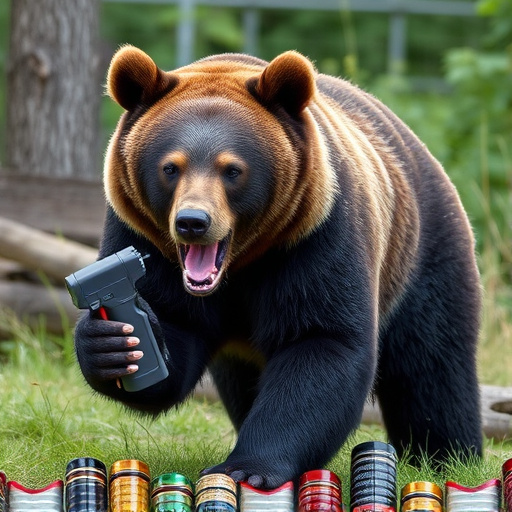Bear spray, a capsaicin-based repellent, is crucial for protecting hikers in national parks from aggressive bears. With varying Bear Spray Laws worldwide, especially in national parks, it's essential to understand local regulations regarding type, quantity, and usage before venturing into bear country. Proper use involves adhering to best practices like maintaining a clear line of sight, aiming for the face, combining spray with noise and retreat, keeping the can accessible, and regular inspections for damage, ensuring maximum effectiveness in bear encounters.
“Unveiling the Power of Maximum Strength Bear Spray as a Vital Defense Weapon in National Parks: An Essential Guide. Bear spray, an innovative self-defense mechanism, has emerged as a game-changer for outdoor enthusiasts navigating rugged landscapes. This article delves into the intricacies of bear spray, focusing on its maximum strength variant—its unique features, benefits, and why it’s a must-have for any adventure in national parks. We also explore critical Bear Spray Laws National Parks, ensuring responsible usage.”
- Understanding Bear Spray: What It Is and How It Works
- Maximum Strength Bear Spray: Features and Benefits
- Bear Spray Laws in National Parks: A Comprehensive Overview
- Safety Tips and Best Practices for Using Bear Spray
Understanding Bear Spray: What It Is and How It Works
Bear spray, also known as bear deterrent or bear repellent, is a powerful tool designed to protect individuals from potential bear encounters in their natural habitats, especially within national parks and wilderness areas. It’s not just any ordinary spray; it’s a specialized product engineered to create a defensive barrier against aggressive bears, primarily grizzly bears and black bears.
The active ingredient in bear spray is typically capsaicin, derived from chili peppers. When sprayed towards an approaching bear, the irritant gets into the bear’s eyes, nose, and respiratory system, causing temporary disorientation and pain. This gives the human recipient a crucial opportunity to retreat or defend themselves. Understanding bear spray laws and its effective usage in national parks is essential for outdoor enthusiasts and visitors ensuring their safety while appreciating nature.
Maximum Strength Bear Spray: Features and Benefits
Maximum Strength Bear Spray is designed to be a powerful defense tool for individuals facing potential bear encounters in wild areas, including national parks. With strengths varying from 4% capsaicin (the active ingredient) up to an impressive 30%, this type of spray offers enhanced protection compared to regular varieties. The higher concentration ensures that even aggressive bears will back off when sprayed directly into their faces, providing a crucial window for escape or reassessment of the situation.
One key benefit lies in its convenience and ease of use. Bear spray can be easily carried as part of a hiking gear setup, ensuring quick access during an encounter. Additionally, these products often come with practical features such as easy-to-use triggers, long-range aerosol delivery systems, and weather-resistant cans, making them reliable allies for outdoor enthusiasts navigating bear country under varying conditions. Compliance with local Bear Spray Laws in national parks is crucial for safety and responsible recreation.
Bear Spray Laws in National Parks: A Comprehensive Overview
In many national parks across the globe, carrying bear spray is not just recommended but mandated for visitors’ safety. These regulations vary widely from park to park, depending on local wildlife populations and visitor activity levels. National Park Services often enforce strict rules regarding the type, quantity, and storage of bear spray to ensure maximum effectiveness and minimize environmental impact. For instance, some parks may limit users to carrying only approved, non-aerosol bear spray containers designed to reduce wildlife hazards. Others might mandate that spray be stored in designated, secure locations within a visitor’s accommodation.
Understanding these Bear Spray Laws in National Parks is crucial for any adventurer planning to traverse wilderness areas. Non-compliance can result in fines or even expulsion from the park. Visitors are encouraged to familiarize themselves with specific rules governing bear spray possession and use before entering any national park. This proactive measure not only ensures compliance but also empowers individuals to protect themselves and appreciate their natural surroundings safely.
Safety Tips and Best Practices for Using Bear Spray
Using bear spray as a defense weapon requires careful consideration and adherence to safety tips for maximum effectiveness. Always check local regulations, including those specific to National Parks, before carrying any type of spray. Different regions have varying rules regarding where and how it can be used. Familiarize yourself with these laws to avoid any legal repercussions.
Best practices include ensuring a clear line of sight between you and the bear, aiming for the face and eyes, and using the spray in conjunction with other defensive strategies like making noise and backing away slowly. Keep your spray readily accessible and ensure it’s properly stored when not in use. Regularly inspect the can to check for any damage or degradation, as this can affect performance.
In conclusion, bear spray maximum strength serves as a vital defense weapon for outdoor enthusiasts navigating national parks with bear populations. Understanding its operation, adhering to relevant laws regarding bear spray possession, and following safety best practices are key to ensuring a secure and enjoyable experience in these natural habitats. Staying informed about local Bear Spray Laws in National Parks can help prevent accidents and promote peaceful coexistence with these majestic creatures.
